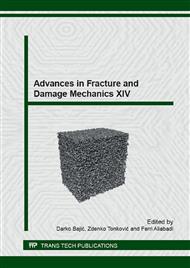p.93
p.97
p.101
p.105
p.109
p.113
p.117
p.121
p.125
Calibration Function for Fatigue Crack Propagation
Abstract:
Components and structures exposed to elastic dynamic loading respond with different surface or bulk material changes which could be monitored on the through surface deformation measurements. The measurements could be performed with electronic devices used for on-line computerized measurement systems. Fatigue induced flaw growth was monitored on a 4-point specimen, loaded by cyclic dynamic bend forces. The flaw growth was monitored by strain gauges and analyzed to determine the shape, propagation and cross sections of the crack. To determine the stress intensity factor a numerical model was developed based on measured crack shapes, material properties and cyclic loading data of the actual tested specimen. The analyses results showed that derived calibration curve could be used to predict surface deformations as a result of crack propagation and growth. With the determination of surface deformation, one could follow the crack transition from surface crack to through thickness crack. The goal of this paper is to describe methodology and results based on experimental analysis during crack propagation and potential use of this technique for online monitoring purposes.
Info:
Periodical:
Pages:
109-112
Citation:
Online since:
September 2015
Authors:
Price:
Сopyright:
© 2016 Trans Tech Publications Ltd. All Rights Reserved
Share:
Citation:


